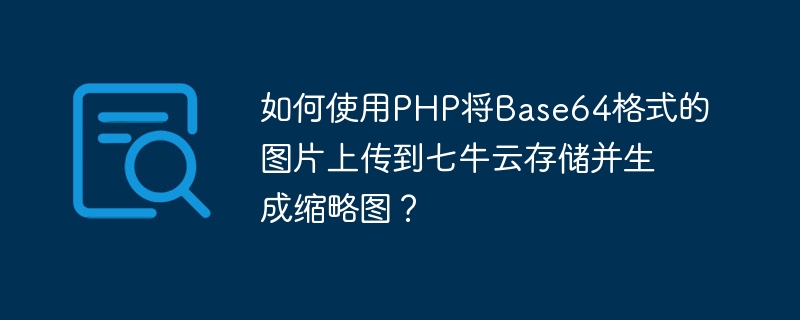

How to use PHP to upload images in Base64 format to Qiniu Cloud Storage and generate thumbnails?
Introduction:
With the development of the Internet, the application of images is becoming more and more widespread, and image processing has also become a common requirement. Qiniu Cloud Storage provides convenient image storage and processing services. This article will introduce how to use PHP to upload images in Base64 format to Qiniu Cloud Storage and generate thumbnails.
Step 1: Install the necessary dependencies
Before starting, we need to ensure that PHP and Composer (PHP dependency management tool) have been installed on the system. At the same time, you also need to use the SDK (Software Development Kit) provided by Qiniu Cloud Storage to connect to Qiniu Cloud Storage.
Please make sure you have installed PHP and Composer, and use the following command to install the Qiniu Cloud Storage SDK:
composer require qiniu/php-sdk
Step 2: Write a function to upload images
The following is an example PHP function, used to upload images in Base64 format to Qiniu Cloud Storage:
<?php
require_once 'vendor/autoload.php'; // 引入七牛云存储的SDK
use QiniuAuth;
use QiniuStorageUploadManager;
function uploadToQiniu($accessKey, $secretKey, $bucket, $base64Image, $fileName)
{
// 生成上传凭证
$auth = new Auth($accessKey, $secretKey);
$token = $auth->uploadToken($bucket);
// 初始化上传对象
$uploadMgr = new UploadManager();
// 将Base64格式的图片转为二进制格式
$fileData = base64_decode($base64Image);
// 上传图片
list($ret, $err) = $uploadMgr->put($token, $fileName, $fileData);
if ($err !== null) {
return false;
} else {
return true;
}
}
?>Please replace the accessKey, secretKey, and bucket in the function with your Qiniu Cloud Storage related information. This function accepts 5 parameters: accessKey and secretKey are your key information, bucket is the name of your storage space, base64Image is the Base64 format image to be uploaded, and fileName is the file name after uploading.
Step 3: Use the function to upload images and generate thumbnails
The following is a sample code that demonstrates how to use the function just written to upload images in Base64 format and generate thumbnails:
<?php
$accessKey = ""; // 替换为七牛云存储的accessKey
$secretKey = ""; // 替换为七牛云存储的secretKey
$bucket = ""; // 替换为七牛云存储的bucket名称
$base64Image = ""; // 替换为待上传的Base64格式图片
$fileName = ""; // 替换为上传后的文件名
if (uploadToQiniu($accessKey, $secretKey, $bucket, $base64Image, $fileName)) {
echo "图片上传成功!";
// 生成缩略图链接
$thumbnailUrl = "http://".$bucket.".qnssl.com/".$fileName."?imageView2/1/w/200/h/200";
echo "缩略图链接:".$thumbnailUrl;
} else {
echo "图片上传失败!";
}
?>Please replace $accessKey, $secretKey, $bucket, $base64Image and $fileName in the code with your Qiniu Cloud Storage related information.
Conclusion:
Through the above steps, we can easily upload images in Base64 format to Qiniu Cloud Storage and generate thumbnails. Qiniu Cloud Storage provides a wealth of APIs and tools to facilitate developers to store and process images. In practical applications, we can use other functions of Qiniu Cloud Storage according to business needs, such as custom styles, image watermarks, etc., to achieve a better user experience.
The above is the detailed content of How to use PHP to upload images in Base64 format to Qiniu Cloud Storage and generate thumbnails?. For more information, please follow other related articles on the PHP Chinese website!